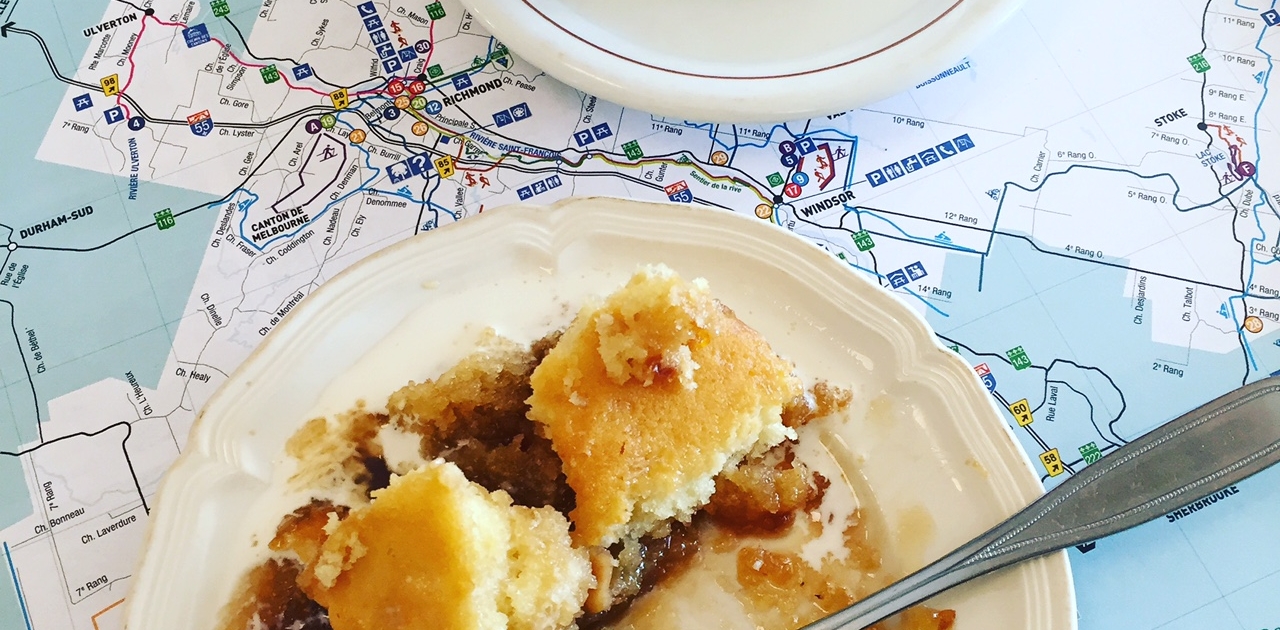
«Pouding chômeur»… ou LinkedIn et le nouveau ‘village global’ – EN
The owner of the coffee shop places the dessert and a cup of espresso on the table in front of me. I look at the plate and start laughing…!
It’s pudding chômeur, a French-Canadian delicacy that literally translates to ‘unemployment pudding’ or ‘poor man’s pudding.’
You see, for the last three months I have been unemployed – or, correction – my position has been that of a full-time job seeker. Every morning I get up, have breakfast and help my kids get ready to go to daycare. After dropping them off, I come back home and set up on the kitchen table with a few books and my laptop. (I have an office in the living room but I much prefer the way the sunlight illuminates the kitchen.)
I worked for five years for my previous employer. One day, I was invited to an informal meeting where I was told without further ado my position had been eliminated (with no hope of reinsertion) and I was shown out of the meeting while being thanked for my years of service. I was completely floored. I left the room in a state of shock, feeling like I had been hit by a bus while crossing the street. I was so invested in some of my projects I felt like an astronaut who hears a far-off voice telling him his mission has been aborted and he is to drop everything and come back to earth.
Sitting at my desk that afternoon, I came to realize my life was going to alter dramatically, that I was about to embark on one of those life changes we so often hear about. Already, in my mind, I was analyzing the ramifications this administrative decision was going to have on my life and that of my young family.
The « game » has changed
We keep hearing the job market isn’t what it used to be. The previous generation of workers could expect to work for the same employer throughout their lifetime, whereas nowadays, flexibility and versatility are what count in an employee.
I come from a rural background where values have stayed the same. Before moving to a major city, I swam in familiar waters where your resume often boiled down to the name and reputation of your family. But in an urban environment, human resources people receive hundreds of resumes from virtual strangers that they then have to quickly go through in order to find THE perfect candidate.
These days, seeking employment can be compared to playing a high-caliber sport. In hockey, for example, the athletes who stand out are invited to attend a training camp where they’ll seek to outperform other competitors, trying to convince potential employers of their superiority by showcasing their particular talent and skills.
And it’s not enough to be talented. You also have to know how to present yourself without succumbing to nervousness during the interview (some would say a mini-trial) where strangers judge your market value, your qualities, your experience and their potential return on investment should they decide to hire you.
The digital village
The majority of employers have a company page on LinkedIn. When a recruiter receives your CV, he types your name into a search engine in search of your ‘digital’ fingerprints, your Facebook, Twitter, LinkedIn or Instagram accounts, the presence – or absence – of your name in industry articles or media events or any other public reference that would have merited you a mention in the world of internet users. Invariably, the employer will go consult your LinkedIn profile.
Needless to say, you’d better have done your homework.
These days, LinkedIn represents an important tool for those looking to find employment.
For this reason, after updating my resume, I took the time to review my entire LinkedIn profile. I updated my list of employers, the description of each position, the achievements associated with each position, examples of particularly successful campaigns and projects. Following the suggestions found on the web and those found on the LinkedIn site itself, I called on former colleagues asking them to write me a short recommendation, two to three phrases underlining the results of my work and the quality of our collaboration.
Breaking the ice
The idea behind LinkedIn is to give the potential employer everything he needs to give them a good idea of your professional skills, but also of you as a person, everything that is so difficult to communicate in a 350-word letter of intent and a bullet point resume not exceeding two pages.
In the absence of human contact, LinkedIn seeks to replace that first handshake and the look in one’s eye that say so much about the quality of the person who has just asked you to trust in him and invite him to become part of your team, someone who says he is capable of taking the ball (or puck) and helping the organization or business score some goals, reach objectives proposed by an annual strategic plan, answer expectations from the head office or from stockholders. Like Bob Dylan sings in one of his songs, no matter where you find yourself on the hierarchal ladder, sooner or later we all have to ‘serve somebody.’
‘’ You may be a businessman or some high-degree thief
They may call you Doctor or they may call you Chief.
But you’re gonna have to serve somebody, yes indeed
Well, it may be the devil or it may be the Lord
But you’re gonna have to serve somebody.’’– Bob Dylan
The challenge these days is to find a way to re-humanize the application process. LinkedIn lets job seekers break through the anonymity, hold out a hand – some might say a digital hand, but at least a tangible if not palpable representation – to strangers. This networking lets job seekers discover individuals that are part of the team they are seeking to join.
And the results are startling. I was pleasantly surprised to discover generous people who took the time to respond to the requests for information I was sending them via LinkedIn’s internal email service. Using LinkedIn advanced searches, I was able for example to learn the name of the HR rep who – hidden to the outside world – had received my resume, as well as the name of the person who would potentially be my ‘’boss.’’ I could then consult the person’s profile and try to understand their career path and even invite them to become part of my professional LinkedIn network.
This is a whole new way of doing things, a new communications tool, a new networking tool. In my opinion, the important thing about LinkedIn is it represents a way to break down the walls of anonymity in order to add crucial elements to our professional profile: human traits, a personality, the sound of a voice, all of the ‘plus value’ that transcends the words found under the headings: name, coordinates, experience, education, references.
Every day, I drop off the kids at daycare and I sit in front of my computer in order to continue my apprenticeship. I still have a long way to go before mastering the topic, before finding answers to all my questions, but like a career coach recently told me, ‘’you’re on the right road.’’
And the pudding? Délicieux!
Share this entry
This post is also available in: French


